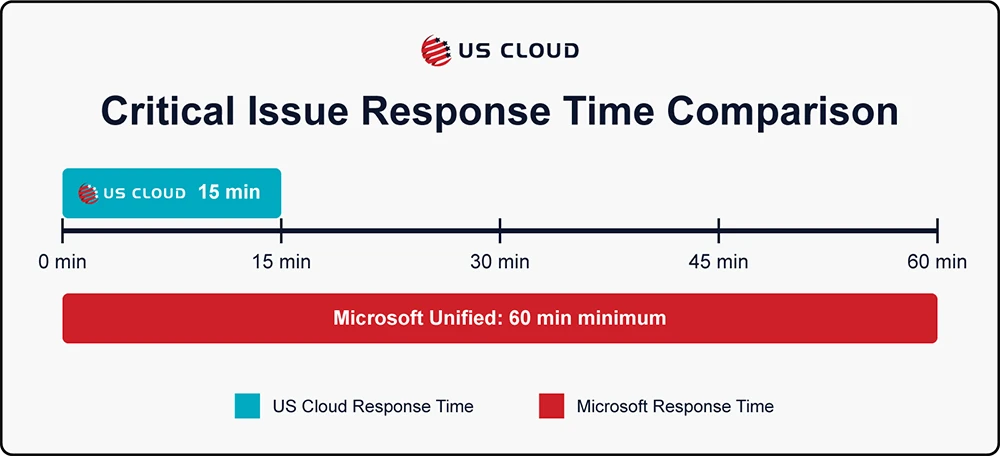
How Much Is Microsoft Enterprise Support?.

Microsoft enterprise support is a critical service for organizations that rely heavily on Microsoft products and services. However, the cost of this support can vary significantly depending on the plan selected and the provider.
Bottom Line: Microsoft Unified Support costs are calculated based on your overall IT spend through Microsoft, not on how much support you need. See below for a pricing breakdown.
Microsoft Unified Support: Pricing Overview
Microsoft Unified Support Contract prices start at $50,000 and grow from there based on how your annual IT spend fits into their pricing model.
Beyond that, Microsoft Unified Support at one point offered three main tiers: Core, Advanced, and Performance. Each tier provides varying levels of service, with costs tied to your organization’s annual Microsoft spend. As of 2025, the pricing structure has been adjusted to better accommodate this year’s IT landscape and increased cloud adoption.

Now, for Microsoft Unified Enterprise, there is only one format for service and the total cost for each tier is calculated as a percentage of your organization’s annual Microsoft spending, encompassing software licenses, Azure subscriptions, and other services. These percentages are applied to your organization’s historical IT spending, including:
- Your most recent 12 months of purchases for cloud services (Microsoft 365, Dynamics 365)
- Your last 12 months of spend on Azure consumption (after discounts but before credits are applied)
- The amount you spent on license-only purchases in the last 12 months
- Any previous purchases on Software Assurance, License + Software Assurance within the last 12 months
It’s important to note that as your organization’s investment in Microsoft products and services grows, the cost of Unified Support may increase correspondingly.
Different Microsoft Unified costs are attributed for what you need support for, including an Azure-based infrastructure, an on-premises infrastructure, or user-based apps through Microsoft. See below for the pricing breakdown based on your spend.
Microsoft Unified Support for an Azure Infrastructure
| Historical IT Spend for Last 12 Months | Percentage of IT Spend That Becomes Your Microsoft Unified Cost |
|---|---|
| $0 – $1.8M | 10% |
| $1.8M – $6M | 7% |
| $6M – $12M | 5% |
| $12M – $30M | 3% |
| $30M – $60 M | 2.25% |
| $60M – $120M | 2% |
| >$120M | 1.75% |
Microsoft Unified Support for an On-Prem Server Infrastructure
| Historical IT Spend for Last 12 Months | Percentage of IT Spend That Becomes Your Microsoft Unified Cost |
|---|---|
| $0 – $1.8M | 10% |
| $1.8M – $6M | 7% |
| $6M – $12M | 5% |
| $12M – $30M | 3% |
| $30M – $60 M | 2.25% |
| $60M – $120M | 2% |
| >$120M | 1.75% |
Microsoft Unified Support for User-Based Apps (Modern Work, Biz Apps, On-Prem Users)
| Historical IT Spend for Last 12 Months | Percentage of IT Spend That Becomes Your Microsoft Unified Cost |
|---|---|
| $0 – $1.5M | 7.5% |
| $1.5M – $3M | 6.5% |
| $3M – $6M | 5.5% |
| $6M – $15M | 4.5% |
| >$15M | 3.5% |
For all plans, the percentages decrease for higher spend tiers. In other words, the rates are graduated, applying progressively to different portions of the total spend. That means, for example, that if your annual Azure spend is $6M, only the first $1.8M of your spend would be assessed at 10% for your Unified Support cost. Then the next $4.2 million would be considered at a 7% rate for your Support costs.
Bottom line: the higher your annual IT spend on Microsoft product, the higher your Microsoft Unified Support cost is. This price increase does not necessarily correspond to your team’s actual Microsoft Support needs. You could increase your product spend but keep your ticket submissions the same and still have to accommodate a Microsoft Support price increase.

Organizations can expect an average 9% year-over-year increase in Unified Support costs from 2024 to 2027. Alongside this, some organizations might see a significant spike in support costs as Azure migrations are completed and cloud consumption increases.
For larger and growing enterprises, these costs can quickly escalate, especially if your Microsoft spend increases over time. The percentage-based model can make budget forecasting challenging, as your costs are directly tied to the fluctuating spend on Microsoft products and services.
Also, it’s important to note that Microsoft conducts semi-annual local currency pricing assessments to align with USD fluctuations, which may affect pricing in different regions.
Why Enterprises Are Switching from Microsoft Unified Support
Many enterprises are reevaluating their reliance on Microsoft Unified Support due to rising costs and inconsistent service quality. Here’s some common concerns:
- Lack of price protection in multi-year agreements.
- Outsourced support leading to slower response times and less personalized service.
- High fees for services that may not be fully utilized by the organization.
To address these challenges, companies are seeking alternative support models that offer more predictable pricing and enhanced customer service. This shift is driven by the need to optimize IT budgets without compromising on support quality.

US Cloud: A Cost-Effective Alternative
US Cloud offers a compelling alternative to Microsoft Unified Support by providing similar or superior service levels at significantly reduced costs. Our transparent pricing model eliminates the unpredictability associated with Microsoft’s percentage-based fees.
Pricing Comparison
- US Cloud Premier Support for Less: annual US Cloud costs offer a savings of 30-50% compared to Microsoft Unified Support.
- Lower Minimum Contract: Cut costs with a significantly lower minimum contract and a locked-in rate.
- Pay-As-You-Go Pricing Model: only pay for actual support usage, not a price based on how many Microsoft products your system uses.
Key Advantages
- Faster Response Times: We guarantee a 15-minute response time for critical issues (Severity A-C), compared to Microsoft’s 1-hour minimum for most plans.
- Dedicated Engineers: Unlike Microsoft’s outsourced support teams, US Cloud provides U.S.-based engineers who offer personalized service tailored to your organization’s needs.
- Security Assurance: We ensure “Support Sovereignty,” meaning all support is handled by U.S.-citizens without offshore involvement—an important consideration for industries with strict compliance requirements.
When you switch to US Cloud, organizations like yours not only reduce costs but also experience improved service quality and faster issue resolution.
Schedule a Call with US Cloud Today
If you’re ready to reduce your Microsoft enterprise support costs by 30-50% while improving service quality, US Cloud is here to help. Our expert team provides faster response times, personalized service, and unmatched security—all at a lower price point than Microsoft Unified Support.
Don’t wait: take control of your IT budget and enhance operational efficiency by switching to US Cloud. Schedule a call today to talk to our enterprise support experts.



